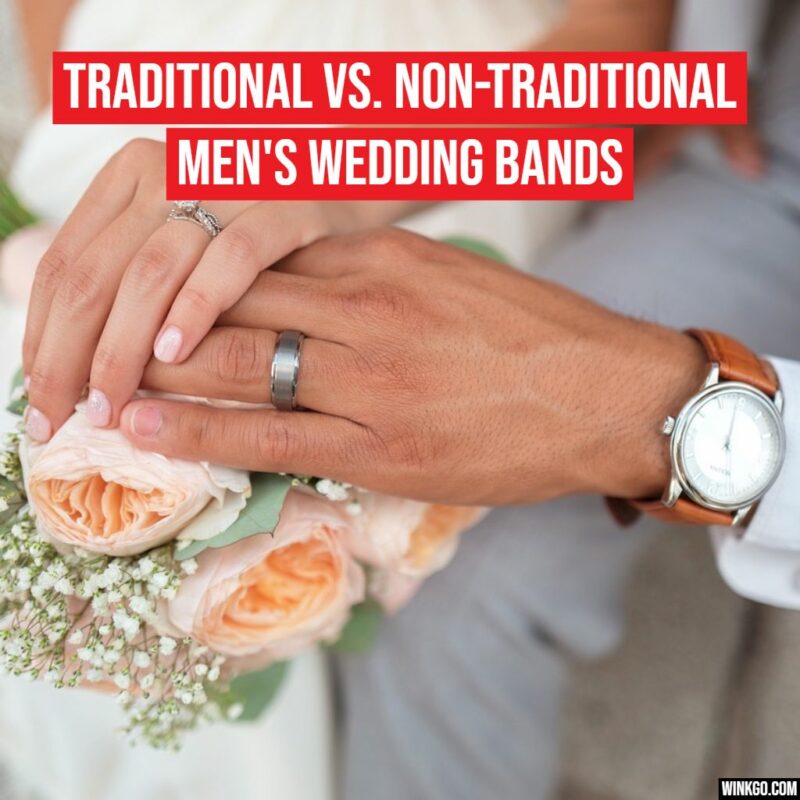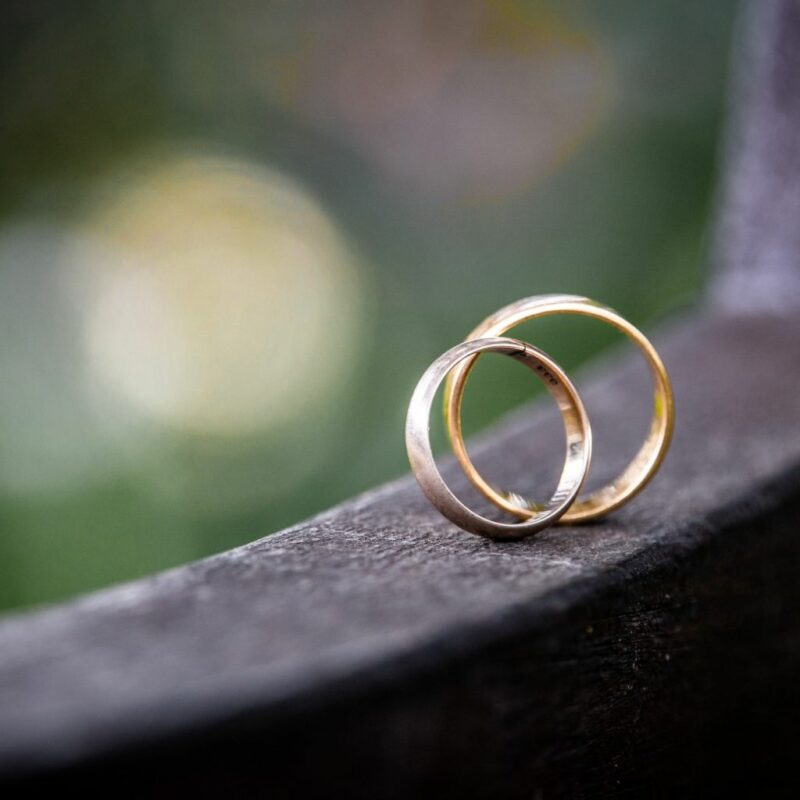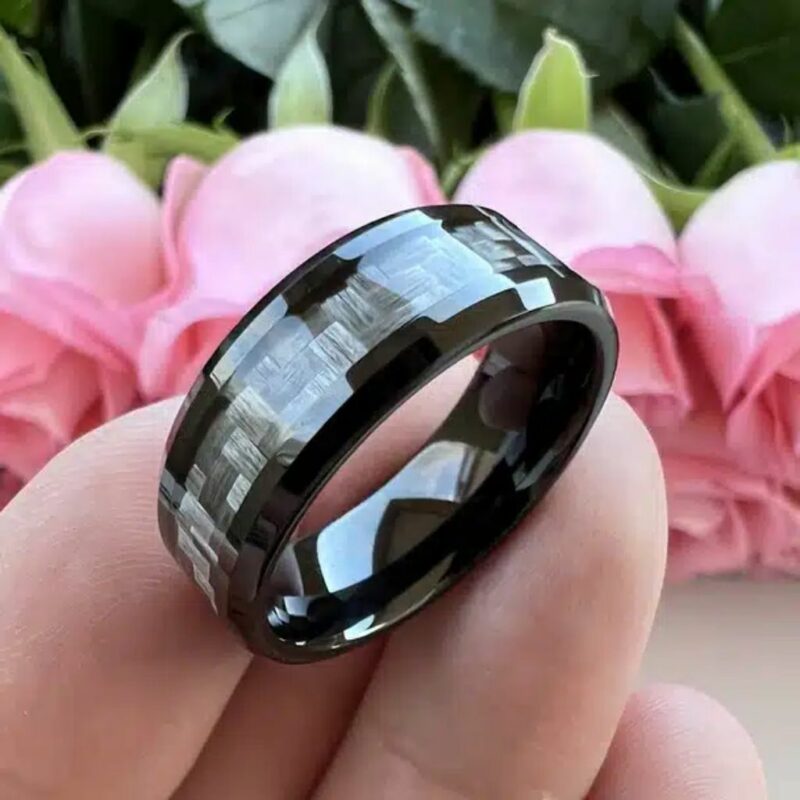Men’s wedding bands are known to be simple yet bold. However, a new strain of wedding bands that are made from other materials and possess some unique aesthetics has begun to gain popularity. The former are the traditional wedding bands, usually made from metals, while the latter are the non-traditional wedding bands.

Although traditional men’s wedding bands appeal to men who espouse classic and simple styles, non-traditional wedding bands suit men who are adventurous and willing to explore the other aesthetic facets that non-traditional men’s wedding bands offer.
This piece will help you to understand traditional and non-traditional men’s wedding band appeals. You’ll also know what to consider when you’re about to choose between them.
Traditional Men’s Wedding Bands

While you may not find many men wearing their wedding bands in the past decade, those who do lean towards traditional bands. They are usually men whose marital statuses provide a higher level of recognition and responsibility and need to be announced subtly.
Traditional men’s wedding bands are typically simple and understated in design, featuring narrow widths but comfortable fit. They are often made of materials like gold and platinum. These bands are usually plain with minimal adornments, although some may feature subtle engravings or decorative details.
Traditional men’s wedding bands are timeless and possess a classic appearance, making them a popular choice for those who prefer a more conservative and traditional style for their wedding rings.
Common Traditional Men’s Wedding Bands
While men’s wedding bands are classified based on the materials they are made from, they can also be categorized based on style and design. Therefore, traditional wedding bands can be made from metal but possess some nontraditional designs.
The common traditional men’s wedding bands include the following:
White Gold bands
White gold is made by mixing gold with white metals, including nickel, palladium, or silver. It is then plated with rhodium to give it a bright, silvery-white finish. White gold bands have a classic and elegant appearance, resembling platinum, but at a more affordable price. They are durable and resistant to tarnishing, making them a popular choice for traditional wedding bands. White gold complements various skin tones and pairs well with different styles and gemstone accents if desired.
Rose Gold bands
Rose gold gives a warm, pinkish hue. It’s sometimes mixed with a bit of silver to adjust the color. Rose gold bands have a romantic and vintage appeal due to their unique color. They offer a subtle and timeless look.
While not as strong as white gold or platinum, rose gold is still durable and can be a suitable choice for a wedding band. Rose gold’s warm and rosy tones add a touch of elegance to traditional men’s wedding bands, making them stand out from the more common white and yellow gold options.
Yellow Gold bands
Yellow gold is the most traditional wedding band choice. It is pure gold mixed with alloy metals like copper and silver. Yellow gold has a rich, warm color that symbolizes luxury and enduring love. It exudes a sense of timelessness. It is a durable and long-lasting metal choice for wedding bands. Yellow gold complements a wide range of skin tones and is a timeless and traditional option that never goes out of style.
Platinum bands
Platinum is a dense, naturally white metal known for its purity and rarity. It is a top choice for high-quality traditional wedding bands. Platinum bands have a bright, white-silver color and a luxurious, understated appearance. Platinum is highly durable and resistant to wear and tear, making it an excellent choice for a lifetime ring. Platinum is also hypoallergenic, which is great for those with sensitive skin.
Silver wedding bands
Silver wedding bands are typically made from sterling silver, an alloy of 92.5% pure silver and 7.5% copper or other metals. Silver bands have a bright, shiny finish, but they are more prone to tarnishing compared to other metals. They are a cost-effective option, making them suitable for couples on a budget. Silver bands offer a more casual and relaxed style, making them a great choice for those who prefer a less formal look.
Non-Traditional Men’s Wedding Bands

Non-traditional men’s wedding bands represent a departure from the classic and conventional designs typically associated with wedding rings for men as you can find on mensweddingbands.io. These bands break away from the traditional norms regarding materials, styles, and aesthetics to offer a more unique and personalized expression of one’s commitment to one’s partner.
Non-traditional men’s wedding bands often feature alternative materials such as wood, meteorite, carbon fiber, or ceramics to showcase individuality and interests. They can incorporate unusual shapes, patterns, and textures including gemstones, birthstones, or unconventional embellishments that add a touch of color or uniqueness to the ring.
Common Non-Traditional Men’s Wedding Bands
As in traditional wedding bands, non-traditional bands can be categorized by their materials, styles, and design. However, we’ll focus more on the materials.
The common non-traditional men’s wedding bands include:
Wood Bands: They incorporate various types of wood into the design, creating a rustic and natural look that appeals to outdoor enthusiasts and seekers of unique, earthy wedding bands.
Meteorite Bands: They feature real meteorite fragments, lending them a one-of-a-kind cosmic appearance. The Widmanstätten patterns make these rings captivating and ideal for individuals fascinated with the cosmos.
Carbon Fiber Bands: They are lightweight, durable, and have a modern, high-tech look, perfect for those with an active lifestyle and who prefer minimalist design.
Tungsten Carbide Bands: Possess exceptional durability and scratch resistance. They come in various styles, from sleek and contemporary to intricately patterned designs.
Silicone Bands: These are flexible, comfortable, and suitable for active individuals. Available in various colors, they offer a functional and low-maintenance alternative to traditional metal bands.
Ceramic Bands: Come in different shades, like black and white, and offer a sleek, modern appearance. Their scratch resistance and minimalist aesthetic make them a popular choice.
Titanium Bands: They are lightweight but strong and can be anodized to achieve various colors. Their designs often feature a combination of durability and unique style.
Damascus Steel Bands: They are crafted from layered steel, resulting in distinctive patterns. These artisanal bands have a handcrafted, rugged charm and are favored by those seeking a distinctive, industrial look.
Mixed Metal Bands: Combine various metals, creating unique contrasts and visual interest. They cater to those who appreciate the interplay of different metals, resulting in striking and eye-catching designs.
Resin and Acrylic Bands: They can be customized with inclusions like crushed gemstones or other materials that hold personal significance. They allow for a high personalization and create a truly unique and meaningful wedding band.
Factors to consider when choosing between traditional and non-traditional men’s wedding bands
Choosing between traditional and non-traditional wedding bands for men can be tricky, especially if you’re unfamiliar with what may suit you. To make your choice easier, here are some factors you should consider:
Personal Style and Preferences
Your style and preferences should determine your choice between traditional and non-traditional wedding bands. The ideal wedding band should reflect your aesthetic inclinations and desire for what resonates with your style.
Traditional bands exude a timeless and understated elegance. They are well-suited for individuals who prefer a conservative, traditional aesthetic that aligns with their style. On the other hand, non-traditional bands offer a broader range of materials, designs, and customization options. They cater to those who want to express their individuality and interests through their wedding band, making it a unique and personal statement.
Comfort and Lifestyle
Traditional bands, with their smooth and often unadorned designs, are generally comfortable for everyday wear and require minimal maintenance. They are ideal for individuals with a more traditional, office-based lifestyle.
In contrast, non-traditional bands can encompass materials like silicone, carbon fiber, or wood, which are lightweight, flexible, and provide comfort, suitable for those who lead active lives, work with their hands, or engage in sports and activities that may put more stress on the ring.
Longevity and Durability
Traditional materials like gold and platinum are durable, resistant to tarnishing, and can withstand the test of time. They are ideal for individuals who seek a ring that will retain its beauty and significance throughout the years. Non-traditional materials, while often offering unique aesthetics, may vary in their resilience to wear and tear.
It’s important to evaluate the durability of materials like titanium, tungsten, or ceramics and ensure they can withstand the rigors of daily wear. This consideration is especially vital for those who intend to wear the ring as a lifelong symbol of their commitment.
Budget
Budget is a crucial factor in the decision-making process between traditional and non-traditional men’s wedding bands. Traditional materials like gold and platinum can be more expensive due to their precious metal content.
If budget constraints are a concern, individuals may opt for tungsten or stainless steel, which tend to be more budget-friendly while offering a stylish look. Non-traditional bands also provide more room for customization, allowing individuals to choose materials and designs.
Conclusion
Traditional and non-traditional men’s wedding bands fulfill the primary purpose of every wedding band. However, choosing one over the other depends on factors such as your budget and personal style, among others.
Please share these tips to help decide whether to invest in traditional or non-traditional men’s wedding bands with your friends and family.



